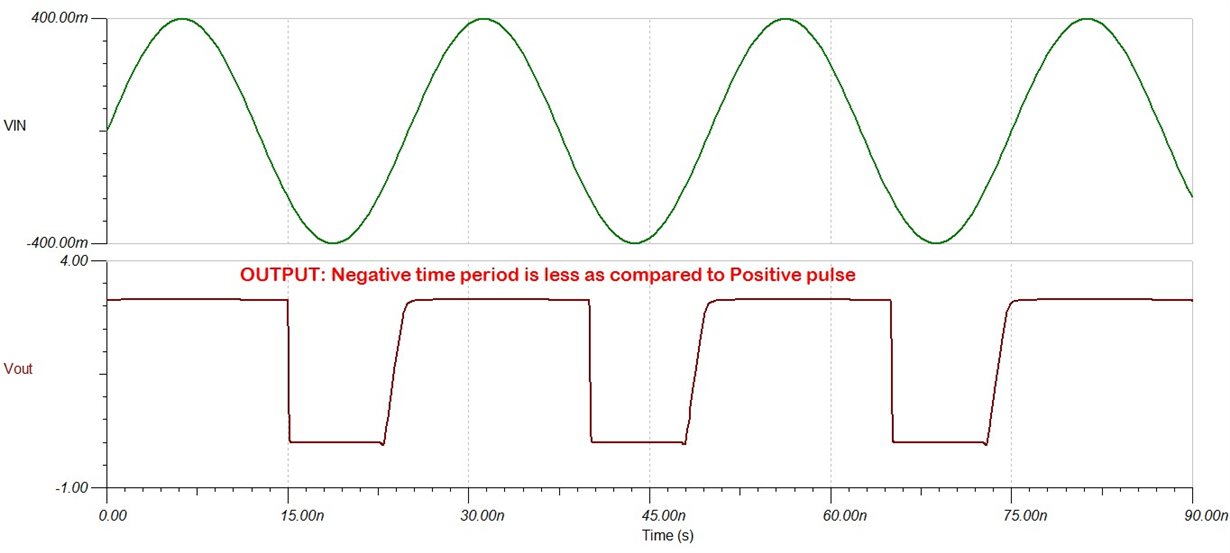Hi Team
I need one Part number which can convert the clipped sine wave ( 1MHz and 10 Mhz ) (0.7pk to pk) to Square wave (5V) .
Regards
Nitesh
This thread has been locked.
If you have a related question, please click the "Ask a related question" button in the top right corner. The newly created question will be automatically linked to this question.
Hi Team
I need one Part number which can convert the clipped sine wave ( 1MHz and 10 Mhz ) (0.7pk to pk) to Square wave (5V) .
Regards
Nitesh
"Clipped" would imply that the signal goes from rail to rail, but then it would not be 0.7 V peak-to-peak.
If the signal were guaranteed to go both below and above the low and high input thresholds, you could use a Schmitt-trigger buffer. With something like the SN74LVC1G17, this would require a swing of at least about 1.5 V. (And if the input signal is not symmetrical about the threshold, the output does not have a 50 % pulse width.)
With such a small amplitude, you have to use a comparator (e.g., TLV3201).
Hey Nitesh,
In addition to what Clemens suggested, I think you could use an SN74LVC1GX04 to accomplish this. This device is usually used to drive a crystal oscillator, and the output of most crystals is a fairly small sine wave (0.5 to 1V in my experience).
The input needs to be AC coupled (add a series capacitor, 0.1uF should work well), then connect directly to the X1 input. Add a feedback resistor from X2 to X1 to provide the appropriate bias -- 100k to 1M should work well.
Then your output shows up at Y.
You may have to tweak some passive values, but the circuit is relatively simple and only requires one ic.
Nitesh
Please provide a picture of the waveform that you want to convert to 5v. Ideally this would be an oscilloscope screen shot so everyone can see the common mode voltage level and signal swing. From your original post it sounds like the amplitude is 0.7v pk-pk but it’s best to confirm with a picture.
From that information we can determine if using a logic gate or a comparator makes sense. If a comparator is best suited, the tlv3201 should be looked at first. If that’s not fast enough, the tlv3501 would certainly work. But let’s hold off on going down this path until you attach a waveform.
Chuck
Hi Clemens
I will try simulating TLV3201 and share the result.
Regards
Nitesh
Nitesh
this waveform is a bit faster, more like 40MHz, so you will need to go with the TLV3501. The propagation delay of the TLV3501 is less than 10ns, so this will be required to handle this higher frequency. The TLV3201 has a prop delay of 40ns, so I can't recommend that device for this higher speed.
Chuck
Thanks for the reply.
I have simulated the same with TLV3501 .But i am not able to get the I/P waveform with 0.8V Pk to Pk.
In my waveform you can see that i have set VIN as 0.8V but waveform is reflecting as 2V.
Can you please check my simulation result let me know what is to be updated.
BR/Nitesh
Hi Jonny
Thanks for the reply. It works
What could be the reason for having Negative pulse is less time period as compared to positive pulse.
Is it so i need to change the discrete to map it equally.Can you please check and let me know.
I am attaching the waveform as well as simulation file for the reference.
Regards
Nitesh